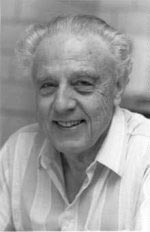

Klaus Ruedenberg

Born August 25, 1920 in Bielefeld, Germany.
Professor Emeritus in Sciences and Humanities, Department of Chemistry and Ames Laboratory, Iowa State University, USA.
Email:ruedenberg@iastate.edu
WWW: external link
Fellow, American Physics Society (1962); Fellow, American Inst. Chem. (1980); Fellow, American Association Adv. Science (1980); Guggenheim Fellow (1966/7); Fulbright Senior Scholar (1982); Member, IAQMS (1973); Midwest Award, Amer. Chem. Soc. (1982); Honor, Ph.D., Univ. Basel (1975); Honor, Ph.D., Univ. Bielefeld (1991); Editor-in-Chief, Theoretica Chimica Acta (1985–).
Author of:
Approximately 150 scientific journals, for example, "The Physical Nature of the Chemical Bond", Rev. Mod. Phys. 34, 326 (1962); "Localized Atomic and Molecular Orbitals", Rev. Mod. Phys. 35, 457 (1963).
Important Contributions:
Ruedenberg has developed, among others, the following new approaches in quantum chemistry:
- Ab Initio Methods: Electron interaction energy integrals between exponential-type atomic orbitals through charge density vectorization (1951–69). Eventempered atomic orbitals as an approach to complete bases (1972–79). Self-consistent determination and correlation analysis of separated-pair wavefunctions (1965–70). Symmetric-group-based configuration interaction formalism (1970–74). Symmetry and spin-adapted MCSCF theory based on single excitations and natural orbitals (1976–1987). Full-valence-space MCSCF theory (FORS) and Intra-Atomic Correlation Correction for molecular FORS wavefunctions (1976–1985).
- Analyses of Chemical Bonding: Isomorphism of tight-bonding LCAO model with free-electron-network model and elucidation of spectra of condensed aromatics (1953–62). Physical origin of chemical binding, in particular as regards the roles of kinetic and potential energies (1962–75). Determination, use and significance of localized SCF orbitals in molecules (1963–75). Relation between total energy and total orbital energies in SCF theory (1977). Atoms-in-molecules in MCSCF theory (1979–85). Deduction of non-spherical atom densities in crystals from X-ray scattering data (1985–92).
- Potential Energy Surfaces for Chemical Reactions - Analysis of critical features of PES (1986 to date): Gradient extremals and reaction paths; Bifurcations and transition states; Intersections between potential energy surfaces of like and unlike symmetries.
- Determination of ab initio PES for specific reactions (1977 to date): HNO -> NOH; H2(C2O2)H2 (dioxetane) -> 2H2CO; H2C=CH2 -> 2CH2; Dihydrogen exchange between H2CCH2 and H3CCH3; Ring closure of CO2; Ring opening H2(C3)H2 (cyclopropylidene) -> H2C=C=CH2 (allene); Global potential energy surfaces for ground and excited states of O3.